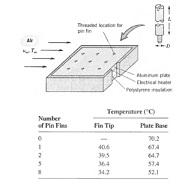Discuss the below in detail:
Q: The objective of an experiment performed by our students is to determine the effect of pin fins on the thermal resistance between a flat plate and an airstream. A 25.9-mm-square polished aluminum plate is subjected to an airstream in parallel flow at T8 = 20°C and u8 = 6 m/s. An electrical heating patch is attached to the backside of the plate and dissipates 15.5 W under all conditions. Pin fins of diameter D = 4.8 mm and length L = 25.4 mm are fabricated from brass and can be firmly attached to the plate at various locations over its surface. Thermocouples are attached to the plate surface and the tip of one of the fins.
Measured temperatures for five pin-fin configurations are tabulated.
(a) Using the experimental observations and neglecting the effect of flow interactions between pins, determine the thermal resistance between the plate and the airstream for the five configurations.
(b) Develop a model of the plate-pin fin system and using appropriate convection correlations, predict the thermal resistances for the five configurations. Compare your predictions with the observations and explain any differences.
(c) Use your model to predict the thermal resistance when the airstream velocity is doubled.
